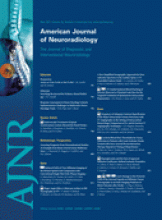We thank Dr Kloska for his insightful remarks on our study, which showed that current CT angiographic source imaging (CTA-SI) may be flow- not volume-weighted.1 We wish to clarify a number of points, specifically as they relate to the technical differences between the study he cites2 and ours. First, we would like to clarify his observations; our contrast injection is routinely followed by 40 mL of normal saline injected at the same rate as the initial contrast bolus. The divergence of our results from those reported in his recent study is most likely attributable to the difference in the order in which CTA and CT perfusion (CTP) were performed in each study.2 In our protocol, CTA was performed while the patient was contrast-naïve. This, coupled with the fact that contrast does not have enough time to reach all the blood vessels in the ischemic/infarct region, suggests that the CTA-SI reflects the arrival time difference between the normal and ischemic regions.
In general, it is always true that a region with a long arrival time would have low blood flow. This explains why the CTA defect in our article is correlated to the blood flow defect. On the other hand in the study cited by Dr Kloska,2 CTA was performed after injection of contrast for a CTP acquisition. By the time CTA is complete, the contrast injected for the CTP study would have time to reach all the blood vessels within the ischemic region, accounting for a smaller CTA-SI defect than when the brain is contrast-naïve.
Dr Kloska suggests that a time delay based on maximum enhancement in the sagittal sinus may account for differences in the 2 studies. We do not find this explanation convincing because the time to maximum sagittal sinus enhancement in a patient with stroke may not be that different from that in a healthy subject because the sagittal sinus drains blood from the whole brain including the normal hemisphere. Indeed, it is the cortical veins, not the superior sagittal sinus, where contrast delay is observed in balloon test occlusions.3 We do not think that the slightly longer delay used in their study would allow enough time for contrast to reach all blood vessels in the ischemic/infarct area; this belief strengthens our initial assertion that differences are related to CTA/CTP order and not to the appropriateness of the contrast injection protocol.
CTA-SI images can be either blood flow– or blood volume–weighted. For a region in the brain where maximum contrast arrival time (Tmax) is shorter than the delay time of the acquisition of the CTA study, the region in the CTA-SI will be blood volume–weighted. Conversely, if Tmax is longer than the delay time of the CTA acquisition, the region in the CTA-SI will be blood flow–weighted. “Tmax” is defined as the time-to-peak of the deconvolved impulse residue function (IRF) as in the Diffusion and Perfusion Imaging Evaluation for Understanding Stroke Evolution study.4 A significant portion of appearance time (T0) is the contrast arrival/T0 at the brain region relative to that of the input arterial function used to calculate the IRF in the deconvolution. We randomly selected 2 acute stroke studies from our data base and found that T0 and Tmax can be as long as 14 seconds and 22 seconds, respectively.
In summary, the possible dual nature of CTA-SI defects, either ischemia or infarct, means that it has to be interpreted together with Tmax or T0 maps and correlated with the scanning time after injection of contrast. This consideration points to the potential pitfall of the use of CTA-SI by itself in acute stroke diagnosis.
References
- Copyright © American Society of Neuroradiology











